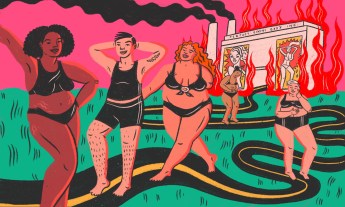
In their book Burnout: The Secret to Unlocking the Stress Cycle, coauthors (and twin sisters) Emily and Amelia Nagoski reveal that completing the stress cycle — finding a way to let our bodies know we’re no longer threatened or in danger and we can stop being stressed — can be the most effective way to avoid burnout and emotional exhaustion. Physical activity or any kind of physical movement is one great way to do this, but there are several other ways.
Here are 6 evidence-based strategies to help you complete your stress cycle:
1. Breathing
Deep, slow breaths down-regulate the stress response, especially when the exhalation is long and slow and goes all the way to the end of the breath so your belly contracts. Breathing is most effective when your stress isn’t that high or when you just need to siphon off the very worst of the stress so you can get through a difficult situation.
A simple, practical exercise is to breathe in to a slow count of 5, hold that breath for 5, then exhale for a slow count of 10, and pause for another count of 5. Do that three times — for one minute and 15 seconds of breathing — and then see how you feel.
Casual but friendly social interaction is the first external sign that the world is a safe place.
2. Positive social interaction
Casual but friendly social interaction is an external sign that the world is a safe place. People with more acquaintances are happier. Just go buy a cup of coffee and say “Nice day” to the barista or compliment another customer’s earrings. Reassure your brain that the world is a safe, sane place, and not all people suck. It helps!
3. Laughter
Laughing together, and even just reminiscing about the times we’ve laughed together, increases relationship satisfaction. We mean belly laughs — deep, impolite, helpless laughter. When we laugh, says neuroscientist Sophie Scott, we use an “ancient evolutionary system that mammals have evolved to make and maintain social bonds and regulate emotions.”
A warm hug in a safe and trusting context can do as much to help your body feel like it has escaped a threat as jogging, and it’s a heck of a lot less sweaty.
4. Affection
Sometimes, a deeper connection with a loving presence is called for. Most often, this comes from a loving and beloved person who likes, respects and trusts you, whom you like, respect and trust. It doesn’t have to be physical affection (though physical affection is great). A warm hug in a safe and trusting context can do as much to help your body feel like it has escaped a threat as jogging a couple of miles, and it’s a heck of a lot less sweaty.
One example of affection is the “six- second kiss” advice from relationship researcher John Gottman. Every day, he suggests, kiss your partner for six seconds. There’s a reason behind the timing: Six seconds is too long to kiss someone you resent or dislike, and it’s far too long to kiss someone with whom you feel unsafe. Kissing for six seconds requires that you stop and deliberately notice you like this person, you trust them and you feel affection for them. By noticing those things, the kiss tells your body that you are safe with your tribe.
Another example: Hug someone you love and trust for 20 full seconds, while both of you are standing over your own centers of balance. Research suggests this kind of hug can change your hormones, lower your blood pressure and heart rate, and improve mood. It doesn’t have to be precisely 20 seconds. What matters is you feel the stress easing, or what therapist Suzanne Iasenza describes as “hugging until relaxed.”
Of course, affection doesn’t stop with other human beings. Just petting a cat or dog for a few minutes can help complete the cycle too.
5. A big ol’ cry
Have you had the experience of just barely making it inside your home — or bedroom — before you slam the door behind you and burst into tears for 10 minutes? Then you wipe your nose, sigh a big sigh and feel relieved from the weight of whatever made you cry? You may not have changed the situation that caused the stress, but you completed the cycle.
Have a favorite tearjerker movie that makes you cry every time? Going through that emotion with the characters allows your body to go through it, too.
You might experience completing the stress cycle as a shift in mood or mental state or physical tension, as you breathe more deeply and your thoughts relax.
6. Creative expression
Engaging in creative activities today leads to more energy, excitement, and enthusiasm tomorrow. Like sports, the arts — including painting, sculpture, music, theater and storytelling in all forms — create a context that tolerates and even encourages big emotions. Arts of all kinds give us the chance to celebrate and move through our big emotions.
P.S.: How do you know you’ve completed the cycle?
It’s like knowing when you’re full after a meal or like knowing when you’ve had an orgasm — your body tells you. You might experience it as a shift in mood or mental state or physical tension, as you breathe more deeply and your thoughts relax.
It’s easier for some people to recognize than others. For some people, it’s as obvious as knowing that they’re breathing. That’s how it is for Emily. Long before she knew about the science, she knew that when she felt stressed and tense and terrible, she could go for a run or for a bike ride and at the end of it she would feel better. She has always been able to feel it intuitively, that shift inside her body.
Don’t worry if you’re not sure you can recognize when you’ve completed the cycle. Especially if you’ve spent a lot of years — like, your whole life, maybe — holding on to your worry or anger, you’ve probably got a whole lot of accumulated stress response cycles spinning their engines, so it’s going to take a while before you get through the backlog.
All you need to do is recognize that you feel incrementally better than you felt before you started. You can notice that something in your body has changed, shifted in the direction of peace.
“If I was at an eight on the stress scale when I started, I’m at a four now,” you can say. And that’s pretty great.
Excerpted from the book Burnout: The Secret to Unlocking the Stress Cycle by Emily and Amelia Nagoski. Copyright © 2019 by Emily and Amelia Nagoski. Used by permission of Ballantine, an imprint of Random House Publishing Group, a division of Penguin Random House LLC. All rights reserved. No part of this excerpt may be reproduced or reprinted without permission in writing from the publisher.
To learn more about the stress cycle and burnout, watch Emily and Amelia Nagoski’s TED conversation:











